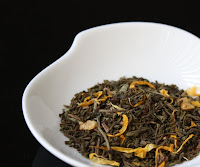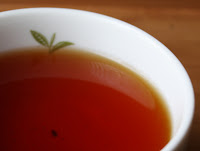 Tea:
Tea: Da Wu Ye - Big Dark Leaf 2008
Vendor: Tea HabitatPrice: $30.00 / oz
Source: Guangdong, China
Vendor Description: Da Wu Ye in literal translation is Big Dark Leaf, one of the 2 main varietals of Phoenix Oolong Tea. This particular varietal is suitable for making Jiang Hua Xiang-Ginger Flower Fragrance Dan Cong tea. Ginger Flower Fragrance Dan Cong is one of the most difficult teas to produce and the most sought after. All Ginger Flower Fragrance Dan Congs are made of Big Dark Leaf varietal, not all Big Dark Leaf varietals can be made into Ginger Flower Fragrance Dan Congs.
Aroma of this tea is magnificent, distinctively pure, subtly rich, shyly beautiful. Flavor is honey water in a desert, nourishment that eases away tension. Texture is rich and buttery. A tea you want to drink if you like to lay on a chaise and day dream.
Leaf: The leaf for this tea had absolutely no dust to it, the leaves were all very large long thin black leaves. All beautifully formed with just a light sweet aroma to them.
1st Infusion Parameters: 5g, 5 oz, 208F, 5s rinse, 45s
 1st Infusion:
1st Infusion: This tea has an absolutely astounding aroma. It is floral with a certain thickness to it. Even within the floral aroma is a calming sweetness. The tea itself is an amber yellow-brown hue. The flavor is very rich and up front. It starts out strong and then tapers to a nice aftertaste. The aroma is bolder than that of any other Dan Cong that I have tried. The taste is floral and pleasant pairing well with the aroma.
2nd Infusion Parameters: 1:15, 208F
2nd Infusion: This time the tea was more of a chestnut brown hue. The aroma is richer and stronger, and a bit less floral. Instead of a floral loftiness it has a more savory thick feel to it, yet despite the thickness it feels clear and clean. The flavor is smooth and pleasant with a light bitterness and finishes with just a hint of astringency. The flavor is quite intense and tapers down into a lingering aftertaste paired with a clean feeling.
3rd Infusion Parameters: 1:45, 208F
3rd Infusion: This infusion was smooth with a little less assertive of a flavor. The core of the flavor is still quite strong, but the sides of the flavor were a little less intense with this infusion. There was not quite as much aroma to this tea this time, which was a bit saddening. The tea felt very graceful with this infusion though.
4th Infusion Parameters: 2:30, 208F
4th Infusion: This infusion had a lighter straw yellow color. The aroma was not very prominent, but it felt very thick and heavy. The flavor was light, and not terribly flavorful, but the tea had a very strong thickness. The underlying flavor was still there, but the forward portion of the flavor wasn't as prominent. There was a medium sense of astringency on the backend.
5th Infusion Parameters: 3:30, 208F
5th Infusion: This infusion had the same straw yellow color to it. The aroma felt the same as it was with the 4th infusion. It was lighter, and a little bit less flavorful this time around. The flavor is thinning out at this point, but it is still light and smooth. It has a long taper to an aftertaste.
6th Infusion Parameters: 6:00, 208F
6th Infusion: The tea was quite honey colored with a light and sweet aroma. The flavor was a bit watery, it showed that there was not much left to this tea. It still has a tastiness to it though which was quite enjoyable.
Rating: 10/10
Conclusion: This tea was absolutely phenomenal. The flavor was strong and intense on the front end and held out for a surprisingly long time. The aroma was in a word; sublime. After doing this review I actually brewed it a few different ways, and the most surprising of which was a 6 oz infusion I made using only 3 leaves. Despite only three leaves being used it had an absolutely sublime aroma again and went for 3 infusions.
 Tea: Mango Green Tea Decaf
Tea: Mango Green Tea Decaf 1st Infusion: This infusion had a brownish caramel hue to it. Considering this was a green tea this was rather surprising. There is a light sweet aroma that quickly fades away. The flavor of the tea is very sharp. There is not much mango in the flavor of this tea at all. Most of the flavor from the tea is up front, but it is very short lived. It quickly dies off leaving not much on the back end. There is no astringency to the back.
1st Infusion: This infusion had a brownish caramel hue to it. Considering this was a green tea this was rather surprising. There is a light sweet aroma that quickly fades away. The flavor of the tea is very sharp. There is not much mango in the flavor of this tea at all. Most of the flavor from the tea is up front, but it is very short lived. It quickly dies off leaving not much on the back end. There is no astringency to the back.






































